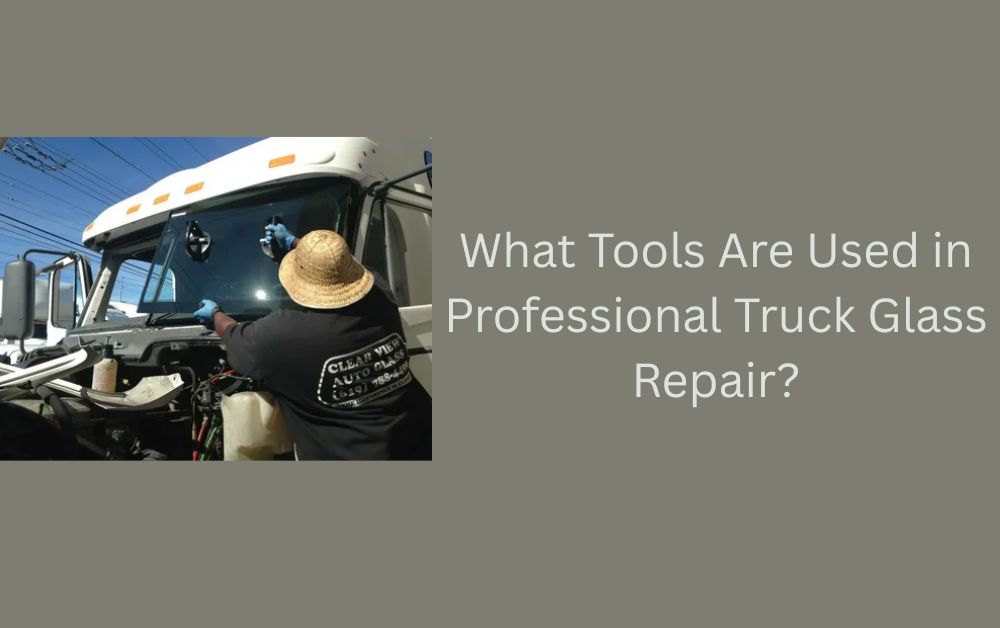When trucks hit the road every day, their windshields and windows face a lot of pressure. From stones flying off highways to sudden temperature changes, glass damage is common in heavy vehicles. A small crack or chip in truck glass may look simple, but if it is ignored, it can grow bigger and create safety risks.
This is where professional truck glass repair comes in. Skilled technicians use a variety of tools and equipment to repair or replace damaged glass in trucks. These tools are designed to make the process safe, accurate, and long-lasting. In this blog, we will explain the different tools used by professionals, why they matter, and how they help keep truck drivers safe on the road.
Why the Right Tools Matter in Truck Glass Repair
Repairing truck glass is not the same as fixing car glass. Trucks have larger, heavier windshields and need strong support. The wrong tool can cause more damage or even lead to a failed installation. That’s why experts rely on high-quality tools.
Benefits of Using Professional Tools
- Accuracy: Helps in repairing cracks properly.
- Safety: Ensures glass does not break during removal or installation.
- Durability: Makes the repair last longer.
- Speed: Reduces time taken for the job, which is important for commercial trucks.
Main Tools Used in Professional Truck Glass Repair
Let’s look at the most important tools that experts use when repairing or replacing truck glass.
1. Windshield Removal Tools
Before repairing or replacing glass, it has to be removed safely.
Cold Knife
A cold knife is a sharp, strong tool with a handle that allows the technician to cut through the adhesive that holds the truck windshield in place. It helps in removing the glass without damaging the frame.
Power Cut-Out Tool
For large trucks, professionals often use a power cut-out tool. This is an electric or battery-powered device that cuts through the urethane (the adhesive used in windshields) quickly. It reduces strain and saves time.
Wire or Cord System
Some experts use a wire or cord system. A strong cutting wire is pulled around the glass edges to slice through the adhesive. This method is safe and reduces the chance of scratching the truck body.
2. Glass Lifting and Handling Tools
Truck windshields are heavy and large, so lifting them by hand is risky.
Glass Suction Cups
These are vacuum-based tools that allow technicians to grip the glass securely. With suction cups, glass can be lifted and moved without slipping.
Glass Lifting Devices
For very big trucks, professionals use hydraulic or electric lifting machines that safely position the glass in place. This prevents accidents and reduces strain on the workers.

3. Cleaning and Preparation Tools
Before a repair or installation, the surface must be cleaned properly.
Scrapers and Blades
Scrapers remove old adhesive or dirt from the frame of the truck. This ensures the new glass sticks firmly.
Glass Cleaner and Cloths
Special glass cleaners are used to wipe dust, oil, and fingerprints. Clean surfaces help adhesives bond properly.
Vacuum Cleaner
A small vacuum may be used to clear dust or broken glass pieces from the truck interior after glass damage.
4. Crack and Chip Repair Tools
Not all damaged truck glass needs replacement. Small chips and cracks can often be repaired.
Resin Injector Kit
A resin injector is one of the most important tools for repairing cracks. It pushes a special liquid resin into the crack, filling the gap and restoring strength to the glass.
UV Light Lamp
After resin is injected, it must be hardened. A UV (ultraviolet) light lamp is used to cure the resin quickly, making the repair strong and clear.
Bridge and Injector Tool
This tool helps position the injector perfectly over the chip or crack, ensuring the resin goes in smoothly without bubbles.
5. Adhesive and Application Tools
When replacing truck glass, adhesives are used to secure the new windshield.
Urethane Adhesive Gun
This is a caulking gun used to apply strong urethane adhesive around the frame. It can be manual, electric, or battery-operated.
Primer Applicator
Before adhesive is applied, a primer is used on the glass edges and frame. A primer applicator ensures even application, helping the glass stick better and preventing leaks.
6. Safety and Protection Tools
Truck glass repair involves risk, so technicians use safety gear too.
Safety Glasses and Gloves
Gloves protect hands from sharp edges, while safety glasses shield eyes from glass splinters.
Protective Covers
Covers are used to protect the truck dashboard and paint during the repair process.
Hard Hats and Work Boots
For large fleet repairs in workshops, technicians wear hard hats and boots to avoid injuries.
Step-by-Step Process of Professional Truck Glass Repair
Now that we know the tools, let’s see how professionals use them in a typical repair.
Step 1: Inspection
- Technicians check the damage and decide whether repair or replacement is needed.
Step 2: Preparation
- Surfaces are cleaned using scrapers, cleaners, and vacuums.
- Safety covers are placed to protect the truck interior.
Step 3: Glass Removal (if needed)
- Cold knives, wires, or power cut-out tools are used to remove old glass.
Step 4: Crack or Chip Repair (if possible)
- Resin injectors and UV lamps are used to fill cracks and harden the resin.
Step 5: New Glass Installation (if replacement is required)
- Suction cups or lifting devices place the new glass.
- Urethane guns apply adhesive.
- Primer applicators prepare the surfaces.
Step 6: Final Check
- Glass is inspected for correct fitting.
- The truck is left to cure before being driven again.
Which Tools Are Essential for Emergency Roadside Repairs?
Sometimes truck drivers need quick fixes on the road. In such cases, technicians carry portable kits.
- Resin injector kit for small chips
- Hand-held UV lamp for curing
- Compact cold knife for emergency removal
- Portable suction cups for lifting glass safely
These tools allow minor repairs to be done without visiting a workshop.
Why Professional Tools Are Better Than DIY Kits
You may see DIY truck glass repair kits online, but they are not always safe.
- Limited strength: DIY kits don’t use professional-grade resin.
- No proper curing: Without a strong UV lamp, resin won’t harden properly.
- Risk of errors: Handling large truck glass without suction cups or lifting tools is dangerous.
That’s why it is always better to trust professionals who have the right tools and experience.
Tips for Truck Owners to Maintain Glass After Repair
Even after a successful repair, proper care is important.
Avoid Rough Roads Immediately
Give the adhesive enough time to cure before driving on rough roads.
Don’t Wash Truck Right Away
Avoid car washes for at least 24–48 hours after replacement.
Check for Leaks
Look for air or water leaks after repair. If noticed, contact the service provider.
Regular Cleaning
Keep the windshield clean with proper glass cleaners, not harsh chemicals.
Conclusion
Truck glass repair is more than just fixing a crack or replacing a windshield. It involves special tools and skilled hands that ensure safety, strength, and long-lasting results. From cold knives and suction cups to resin injectors and UV lamps, every tool has an important role in the process.
By understanding these tools, truck owners and drivers can appreciate the value of professional repair services and avoid risky DIY attempts. After all, clear and strong glass is not just about visibility—it’s about safety on the road.
For more insightful articles related to this topic, feel free to visit writoka



